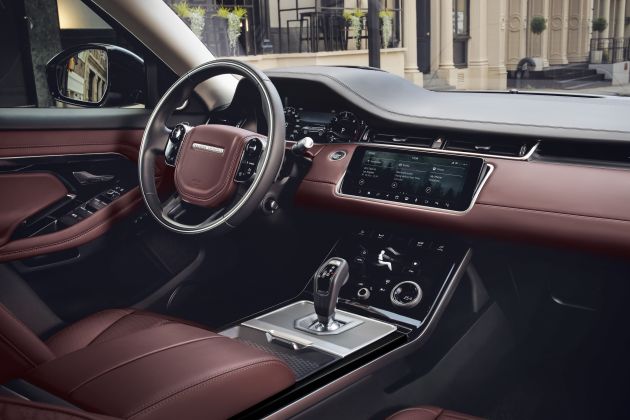This is the new Range Rover Evoque, the second generation of a highly successful, brand-transforming product for Jaguar Land Rover. And as expected for an iconic design, they’ve kept much of what’s good about it intact, while adding new tech and improvements. JLR promises new standards of refinement, capability and sustainability with the new Evoque.
Building on the original’s instantly-recognisable design, the new Evoque is an evolution of the model’s distinctive silhouette, typified by its fast roofline and rising waist. The volume and proportions are amplified by its pronounced shoulders and powerful wheelarches that, along with new 21-inch wheels, combine to create a “strong and dynamic attitude”.
The rear end follows the style introduced by the Range Rover Velar, and so does some cool new details such as the flush door handles. Other new details include jewel-like elements such as the slim Matrix LED headlamps, sweeping directional indicators, and burnished copper accents.
Again, much of the Velar’s interior style is present in the new Evoque’s upgraded cabin. Uncluttered surfaces and simple lines dominate for what LR calls a luxurious, minimalist and digital cabin. Feature highlights include the twin touchscreen Touch Pro Duo system (featuring new, faster software), 16-way seat controls and cabin air ionisation.
Technical textiles that use recycled plastics are offered as premium alternatives to leather, such as a Kvadrat wool blend and Miko Dinamica suedecloth, as well as Eucalyptus and Ultrafabrics options.
“When Range Rover Evoque made its debut back in 2010, it transformed the world of compact SUVs and the new model is set to continue that remarkable journey. This characterful vehicle combines refinement and fun to create that all important emotional reaction that will turn heads and make people smile,” said Gerry McGovern, Land Rover’s chief design officer.
If the proportions of the new Evoque look familiar, the 4.37m footprint is almost identical. However, the second-gen is built on Land Rover’s new mixed-material Premium Transverse Architecture and there’s more cabin space than before. A longer wheelbase yields 20 mm extra rear kneeroom and an increase in small item stowage – the larger glove box and centre cubby can now fit tablets, handbags and bottles with ease, LR says.
The cargo area is wider and 10% larger (591 litres) now, and it can swallow a folded pram or set of golf clubs, with space increasing to 1,383 litres when the 40:20:40 rear seats are folded.
The new architecture has been developed for electrification, with a 48-volt mild-hybrid available at launch and a plug-in hybrid model to surface around a year later. The mild hybrid powertrain is a first for Land Rover and works by harvesting energy normally lost during deceleration. There’s an engine-mounted belt-integrated starter generator to do that, electricity is sent to the 48V under-floor battery via a DC/DC converter.
At speeds below 17 km/h, the engine will shut off while the driver applies the brakes. When pulling away, the stored energy is redeployed to assist the ICE under acceleration and reduce fuel consumption. The result is a refined, quiet and efficient drive in built-up traffic heavy areas, in addition to efficiency savings, LR says.
Available across the range of four-cylinder Ingenium petrol and diesel engines (automatic gearbox only), the mild hybrid delivers CO2 emissions from as low as 149 g/km and fuel economy from 17.8 km/l based on the new WLTP test procedure. More efficiency will come when the PHEV model and three-cylinder petrol Ingenium engine join the Evoque range next year.
The MHEV system is paired with every launch engine except for the base 2.0L D150 2WD Manual. Every other variant comes with an nine-speed automatic transmission and AWD, with engines ranging from the 150 PS/380 Nm D150 to the 300 PS/400 Nm petrol turbo P300, which is good for 0-96 km/h (0-60 mph) in 6.3 seconds.
Stylish as it is, the Evoque is a Range Rover, which means it’s capable off the tarmac. AWD is combined with the second-generation Active Driveline with Driveline Disconnect to enhance efficiency, and Adaptive Dynamics to deliver the optimum balance of comfort and agility.
Terrain Response 2 – technology first found on full-size Range Rover – automatically detects the surface being driven on, and adjusts the set-up accordingly. Water wading capability is now 600 mm, 100 mm up from before.
Last but not least, tech. The new Evoque comes with the segment-first ClearSight rear-view mirror that transforms into an HD video screen. If rear visibility is compromised (by passengers or bulky items), the driver simply flicks a switch on the underside of the mirror and a camera feed from the top of the car displays what is behind the Evoque. The screen provides a wider (50-degree) field of vision and superior visibility in low light, LR says.
The new Evoque is also the first in the world to feature Ground View tech, which effectively makes the bonnet invisible by projecting camera imagery onto the upper touchscreen to show the driver a 180-degree view under the front of the car. This is useful when negotiating difficult parking spaces, navigating high kerbs or tackling rough terrain. It’s the realisation of the Transparent Bonnet tech previewed by the company in 2014.
This is also the first Land Rover with Smart Settings, which uses artificial intelligence algorithms to learn the driver’s preference and acts as an onboard butler of sorts. In addition to seat position, music and climate settings, the new Evoque can also control steering column preferences to maximise comfort and convenience.
Seven years and 772,096 units later, the Range Rover Evoque is still as desirable. Even more so, actually.
https://youtube.com/watch?v=lb3JyTzgEU4%3Ffeature%3Doembed
Source: Read Full Article









